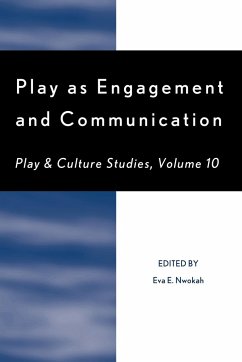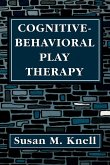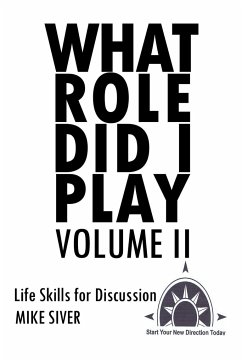Play as Engagement and Communication
Herausgeber: Nwokah, Eva E.
Play as Engagement and Communication
Herausgeber: Nwokah, Eva E.
- Broschiertes Buch
- Merkliste
- Auf die Merkliste
- Bewerten Bewerten
- Teilen
- Produkt teilen
- Produkterinnerung
- Produkterinnerung
This multidisciplinary and varied perspective on play continues the stimulating and informative volumes in the Play and Culture Studies series. The primary focus of the papers in this volume is to reflect on the close relationship between play and the process of engaging and communicating with others in different contexts.
Andere Kunden interessierten sich auch für
![Online Peer Engagement in Adolescence Online Peer Engagement in Adolescence]() Online Peer Engagement in Adolescence53,99 €
Online Peer Engagement in Adolescence53,99 €![Cognitive-Behavioral Play Therapy Cognitive-Behavioral Play Therapy]() Susan M. KnellCognitive-Behavioral Play Therapy91,99 €
Susan M. KnellCognitive-Behavioral Play Therapy91,99 €![Cultivate Hope and Engagement in Your Life Cultivate Hope and Engagement in Your Life]() Michelle J ScallonCultivate Hope and Engagement in Your Life24,99 €
Michelle J ScallonCultivate Hope and Engagement in Your Life24,99 €![What Role Did I Play Volume II What Role Did I Play Volume II]() Mike SiverWhat Role Did I Play Volume II13,99 €
Mike SiverWhat Role Did I Play Volume II13,99 €![Technology Play and Brain Development Technology Play and Brain Development]() Doris BergenTechnology Play and Brain Development67,99 €
Doris BergenTechnology Play and Brain Development67,99 €![101 Favorite Play Therapy Techniques 101 Favorite Play Therapy Techniques]() Heidi Kaduson101 Favorite Play Therapy Techniques83,99 €
Heidi Kaduson101 Favorite Play Therapy Techniques83,99 €![Play and Exploration in Children and Animals Play and Exploration in Children and Animals]() Thomas G. PowerPlay and Exploration in Children and Animals102,99 €
Thomas G. PowerPlay and Exploration in Children and Animals102,99 €-
-
-
This multidisciplinary and varied perspective on play continues the stimulating and informative volumes in the Play and Culture Studies series. The primary focus of the papers in this volume is to reflect on the close relationship between play and the process of engaging and communicating with others in different contexts.
Produktdetails
- Produktdetails
- Verlag: Globe Pequot Publishing Group Inc/Bloomsbury
- Seitenzahl: 236
- Erscheinungstermin: 2. Juni 2010
- Englisch
- Abmessung: 229mm x 152mm x 14mm
- Gewicht: 390g
- ISBN-13: 9780761850830
- ISBN-10: 076185083X
- Artikelnr.: 32738834
- Herstellerkennzeichnung
- Libri GmbH
- Europaallee 1
- 36244 Bad Hersfeld
- gpsr@libri.de
- Verlag: Globe Pequot Publishing Group Inc/Bloomsbury
- Seitenzahl: 236
- Erscheinungstermin: 2. Juni 2010
- Englisch
- Abmessung: 229mm x 152mm x 14mm
- Gewicht: 390g
- ISBN-13: 9780761850830
- ISBN-10: 076185083X
- Artikelnr.: 32738834
- Herstellerkennzeichnung
- Libri GmbH
- Europaallee 1
- 36244 Bad Hersfeld
- gpsr@libri.de
Eva E. Nwokah is an associate professor of communication sciences and disorders at the University of North Carolina, Greensboro. She has held faculty and clinical positions in four countries. Her research interests are in language, play, narrative skills, and social interaction in families, between mothers and infants, and child peer interaction. Her recent work has focused on humor and language play in social interaction. She has been actively involved in local adolescent parenting programs and the implementation of clinical and educational support for language and literacy intervention with high-risk families.
Chapter 1 Foreword Chapter 2 Introduction Part 3 I. Child Play with Adults
and with Animals Chapter 4 1. The Therapuetic Benefits of Play for
Hospitalized Children Chapter 5 2. Play between Children and Domestic
Animals Chapter 6 3. Mothers' Social and Didactic Actions during Play:
Contribution of Infant Affect Part 7 II. The Complexities of Child-Child
Play in Different Contexts Chapter 8 4. The Reality of Pretend Play:
Ethnic, Socioeconomic, and Gender Variations in Young Children's
Involvement Chapter 9 5. Children's Pretend Play with Media-Based Toys
Chapter 10 6. Young Children's Emotional Responses to Cheating in Game Play
Chapter 11 7. Contribution of Theory of Mind to Pretend Play: Concordance
between Preschool Play Partners Part 12 III. Teacher Support for Play in
Educational Settings Chapter 13 8. Rough and Tumble Play in Early Childhood
Settings: Challenges for Personnel Training Chapter 14 9. The Teacher's
Role in Enhancing Sociodramatic Play in Early Childhood Classrooms: A Study
in Head Start Classrooms Part 15 IV. Reflections on the Nature of Play
Chapter 16 10. Play as Ascending Meaning Revisited: Four Types of Assertive
Play Chapter 17 Contributors Chapter 18 Subject Index
and with Animals Chapter 4 1. The Therapuetic Benefits of Play for
Hospitalized Children Chapter 5 2. Play between Children and Domestic
Animals Chapter 6 3. Mothers' Social and Didactic Actions during Play:
Contribution of Infant Affect Part 7 II. The Complexities of Child-Child
Play in Different Contexts Chapter 8 4. The Reality of Pretend Play:
Ethnic, Socioeconomic, and Gender Variations in Young Children's
Involvement Chapter 9 5. Children's Pretend Play with Media-Based Toys
Chapter 10 6. Young Children's Emotional Responses to Cheating in Game Play
Chapter 11 7. Contribution of Theory of Mind to Pretend Play: Concordance
between Preschool Play Partners Part 12 III. Teacher Support for Play in
Educational Settings Chapter 13 8. Rough and Tumble Play in Early Childhood
Settings: Challenges for Personnel Training Chapter 14 9. The Teacher's
Role in Enhancing Sociodramatic Play in Early Childhood Classrooms: A Study
in Head Start Classrooms Part 15 IV. Reflections on the Nature of Play
Chapter 16 10. Play as Ascending Meaning Revisited: Four Types of Assertive
Play Chapter 17 Contributors Chapter 18 Subject Index
Chapter 1 Foreword Chapter 2 Introduction Part 3 I. Child Play with Adults
and with Animals Chapter 4 1. The Therapuetic Benefits of Play for
Hospitalized Children Chapter 5 2. Play between Children and Domestic
Animals Chapter 6 3. Mothers' Social and Didactic Actions during Play:
Contribution of Infant Affect Part 7 II. The Complexities of Child-Child
Play in Different Contexts Chapter 8 4. The Reality of Pretend Play:
Ethnic, Socioeconomic, and Gender Variations in Young Children's
Involvement Chapter 9 5. Children's Pretend Play with Media-Based Toys
Chapter 10 6. Young Children's Emotional Responses to Cheating in Game Play
Chapter 11 7. Contribution of Theory of Mind to Pretend Play: Concordance
between Preschool Play Partners Part 12 III. Teacher Support for Play in
Educational Settings Chapter 13 8. Rough and Tumble Play in Early Childhood
Settings: Challenges for Personnel Training Chapter 14 9. The Teacher's
Role in Enhancing Sociodramatic Play in Early Childhood Classrooms: A Study
in Head Start Classrooms Part 15 IV. Reflections on the Nature of Play
Chapter 16 10. Play as Ascending Meaning Revisited: Four Types of Assertive
Play Chapter 17 Contributors Chapter 18 Subject Index
and with Animals Chapter 4 1. The Therapuetic Benefits of Play for
Hospitalized Children Chapter 5 2. Play between Children and Domestic
Animals Chapter 6 3. Mothers' Social and Didactic Actions during Play:
Contribution of Infant Affect Part 7 II. The Complexities of Child-Child
Play in Different Contexts Chapter 8 4. The Reality of Pretend Play:
Ethnic, Socioeconomic, and Gender Variations in Young Children's
Involvement Chapter 9 5. Children's Pretend Play with Media-Based Toys
Chapter 10 6. Young Children's Emotional Responses to Cheating in Game Play
Chapter 11 7. Contribution of Theory of Mind to Pretend Play: Concordance
between Preschool Play Partners Part 12 III. Teacher Support for Play in
Educational Settings Chapter 13 8. Rough and Tumble Play in Early Childhood
Settings: Challenges for Personnel Training Chapter 14 9. The Teacher's
Role in Enhancing Sociodramatic Play in Early Childhood Classrooms: A Study
in Head Start Classrooms Part 15 IV. Reflections on the Nature of Play
Chapter 16 10. Play as Ascending Meaning Revisited: Four Types of Assertive
Play Chapter 17 Contributors Chapter 18 Subject Index









